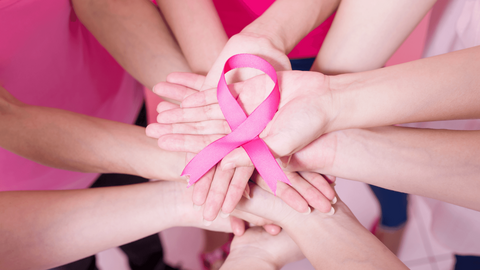Breast Cancer - Symptoms, Causes, and Treatment
Research shows that breast cancer is the second highest cause of cancer-related deaths for women globally. Thus, learning some facts about this disease is crucial. This article provides a comprehensive overview of the types, symptoms, causes, diagnosis, and treatment of breast cancer. Additionally, it will be addressed whether you can protect yourself from breast cancer.

What Is Breast Cancer
Breast cancer is a disease that manifests in abnormal and uncontrolled growth of breast cells into lumps. Cancer cells develop in the milk-producing lobules and milk ducts before multiplying and spreading to adjacent breast tissue and lymph nodes. If untreated, the cancer cells can spread beyond the breasts to the rest of the body and become life-threatening. However, if it is detected early, breast cancer is treatable.
Symptoms of Breast Cancer
Breast cancer can present many different symptoms. The most common breast cancer signs include the following:
Swelling or Lump
The presence of growths or swelling in the armpits or breasts is the most common indication of breast cancer. The affected tissue often feels different from adjacent tissue.
Changes in Breast Shape or Size
Breast cancer can lead to observable variations in the breast shape or size. You may notice shrinkage, asymmetry, or swelling in either or both breasts.
Breast Tenderness or Pain
Although this may not be an obvious indication of cancer, you should schedule a medical evaluation if you experience persistent, localised pain or tenderness in your breast.
Skin Changes
Another primary cancer symptom is changes in breast skin appearance. The changes may be skin puckering or dimpling, redness or thickening.
Nipple Abnormalities
You should notice any unexplained nipple changes with great concern. Such changes include unusual discharge that isn't breast milk, nipple inversion, texture, or shape changes.
It is crucial to note that having these symptoms is not necessarily an indication that you have cancer. The signs can be a result of other non-cancerous conditions. Therefore, you should consult your healthcare provider for further screening and diagnosis if you observe any unusual changes.
Causes of Breast Cancer
There is no known sole cause of breast cancer, but several common factors are associated with the disease. Although these factors do not warrant cancer development, they are essential for prevention and early detection. Some potential causes of breast cancer include:
Genetic Mutations and Family History
Research has revealed some cases where breast cancer runs in families. Thus, you are more likely to develop breast cancer if you have a close relative, such as a sister or mother, with the disease. Also, some inherited genetic mutations substantially increase the probability of breast cancer development.
Personal Breast Abnormality History
Having certain non-cancerous diseases of the breast, like lobular carcinoma in situ (LCIS) or atypical hyperplasia, can increase your likelihood of getting breast cancer. Also, previous chest area radiotherapy treatment for complications such as Hodgkin's lymphoma can lead to the development of breast cancer.
Hormonal Factors
Studies reveal that prolonged lifetime exposure to progesterone and oestrogen hormones contributes to an increased breast cancer risk. Therefore, early menstruation onset (under 12 years of age) and late menopause (beyond 55) can potentially cause breast cancer. Also, women above 30 who have never gotten pregnant are at a higher risk.
Age
Statistics show that breast cancer risk rises with age. Although you can get breast cancer at any age, most diagnosed cases are above 50 years.
Breast Tissue Density
Having dense breast tissue makes mammography imaging challenging, increasing the chances of developing breast cancer. The breast tissue will appear thicker and less fatty, and abnormalities or small lumps may be hard to detect.
Lifestyle Factors
Some lifestyle choices, such as alcohol abuse, a sedentary lifestyle, and obesity can potentially contribute to breast cancer development. You can reduce this risk by making healthy lifestyle choices like exercising regularly and avoiding alcohol.
Types of Breast Cancer
There are various breast cancer types, each with different behaviours and characteristics. Some common types of breast cancer include:
Ductal Carcinoma in Situ (DCIS)
DCIS is a non-invasive early-stage breast cancer. This type of cancer is characterised by the presence of malignant cells only in the milk ducts and has a high survival rate.
Invasive Ductal Carcinoma (IDC)
This type of cancer grows in the milk ducts before invading adjacent tissue. IDC has the highest prevalence and can spread throughout the body if left untreated.
Lobular Carcinoma in Situ (LCIS)
LCIS develops in the milk glands and is often considered non-cancerous. However, its presence indicates an increased risk of invasive breast cancer. LCIS is not detectable by mammography.
Invasive Lobular Carcinoma (ILC)
ILC is an invasive type of cancer that develops in the milk lobules, spreading to surrounding tissue and other body parts if untreated. Although ILC is less common than IDC, they have common characteristics.
Paget's Disease of the Nipple
This kind of cancer is less common; it develops in the milk ducts and then spreads to the areola and nipples, causing itching, crusting, and redness in the nipple area.
Inflammatory Breast Cancer
This aggressive and rare breast cancer type progresses rapidly and is characterised by breast inflammation, swoleness, and redness.
Phyllodes Tumours
These are rare benign tumours that grow in the breast connective tissue with the potential of becoming cancerous if untreated.
Diagnosis of Breast Cancer
The process of diagnosing breast cancer involves various stages that help identify the presence and magnitude of the disease. Let's look at the process step by step.
- Clinical breast examination is the foremost step in breast cancer diagnosis. The process involves examining the breasts and adjacent areas by a physician to identify any abnormalities.
- Mammogram: a mammogram is a specialised imaging of the breast (X-ray) that helps detect even minute abnormalities that may be cancerous.
- Breast ultrasound
uses high-frequency sound waves to analyse any doubtful/ inconclusive observations from a mammogram further. A breast ultrasound is also helpful in detecting breast irregularities in women with dense breast tissue, especially younger women.
- Magnetic Resonance Imaging (MRI) involves detailed breast imaging using radio waves and magnetic fields. An MRI scan helps reveal more information on the characteristics, location, and size of suspicious tissue, aiding in determining the scope of the disease.
- Biopsy: a biopsy involves collecting suspicious tissue samples for a laboratory analysis and definitive diagnosis of cancer.
- Biological tests: lastly, the physician may recommend genetic testing to investigate the presence of cancer-related genetic mutations or markers.
Staging: cancer staging involves establishing the spread and extent of cancer in the body. Staging aids in disease prognosis, planning, and identifying the most suitable treatment approach. The process entails evaluating several factors, including tumor size, distant metastasis presence, and lymph node involvement, to assign or identify the stage of cancer (from stages 1 to 4).
Treating Breast Cancer
There are various breast cancer treatment options, and each option is suitable for specific tumour characteristics. They include:
- Surgery is the primary cancer treatment option, and it can focus on removing the tumour (lumpectomy) or the entire breast (mastectomy)
- Radiation therapy is often applied after surgery to get rid of any remaining cancer cells.
- Chemotherapy involves intravenous or oral medication to kill the cancer cells when they are widespread.
- Hormone therapy helps in treating hormone receptor-positive breast cancer.
- Targeted therapy focuses on treating specific cancer cell characteristics.
- Immunotherapy boosts the patient's immunity to help fight cancer.
- Clinical trials involve novel approaches and experimental therapies to help improve breast cancer treatment.
Breast cancer treatment is highly personalised, and the doctor may apply a combination of these treatment options for optimal results, depending on your situation.
Can You Prevent Breast Cancer?
While there is no guaranteed way to prevent breast cancer, there are some measures you can take to minimise your risk of developing the disease. However, it is essential to note that, unfortunately, some people get it regardless of their best preventive actions.
Here are some of the tips that can potentially help reduce your risk of breast cancer:
- Conducting
regular breast self-exams can help you become breast-aware so you can detect and report any unusual changes to your doctor.
- Scheduling
routine clinical breast examinations with your healthcare provider can be helpful in the early detection of potential abnormalities.
- Regular mammograms are crucial in detecting changes in the breasts, especially for women above 40.
- Maintain a
healthy lifestyle: studies suggest that a balanced diet and an active lifestyle can help lower your breast cancer risk.
- Limiting or avoiding alcohol consumption
can reduce your risk of health complications, including breast cancer.
- Avoid post-menopausal
long-term use of hormone therapy.
- Know your family breast cancer history; consult your doctor on additional preventive measures if your family has a breast cancer history.
Conclusion
Breast cancer is among the most significant global health concerns and the second leading cancer death cause for women. Being breast aware is crucial in early detection and recognition of symptoms of breast cancer, which include unusual changes in the look and feel of the breast.
There is no proven breast cancer cause, but some factors such as age, family history, hormonal factors, and unhealthy lifestyle choices can increase your chances of developing the disease. Breast cancer is treatable if diagnosed early. Your doctor will determine the appropriate treatment strategy depending on the diagnosis findings.
Although breast cancer is not preventable, taking steps like regular breast self-exams, routine clinical exams, and screening alongside healthy lifestyle choices can significantly reduce your risk of developing the disease.
References
- Ahlgren, M., Melbye, M., Wohlfahrt, J., & Sørensen, T. I. (2004). Growth patterns and the risk of breast cancer in women. New England Journal of Medicine, 351(16), 1619-1626. Retrieved from https://www.nejm.org/doi/full/10.1056/NEJMoa040576.
- Nelson, H. D., Zakher, B., Cantor, A., Fu, R., Griffin, J., O'Meara, E. S., ... & Miglioretti, D. L. (2012). Risk factors for breast cancer for women aged 40 to 49 years: a systematic review and meta-analysis. Annals of internal medicine, 156(9), 635-648. Retrieved from https://www.acpjournals.org/doi/full/10.7326/0003-4819-156-9-201205010-00006.
- Dupont, W. D., & Page, D. L. (1985). Risk factors for breast cancer in women with proliferative breast disease. New England Journal of Medicine, 312(3), 146-151. Retrieved from https://www.nejm.org/doi/full/10.1056/NEJM198501173120303.

